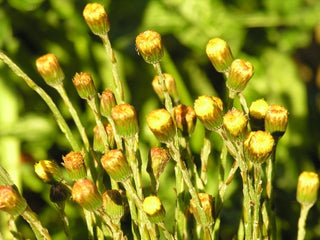Tiny Gardens for Birds & Bees?
Mrs Everybody has been in her tiny front garden. She is not the only visitor. Passing bees hum around the flowers and birds stop to lie down, eat or just stand around here... It is a green, flowery and fragrant oasis. Sadly it is one of the very few little green refuges along a car lined, barren, treeless street, hemmed in by paving slabs and concreted front gardens. A neighbour tells me that she has seen just one bird on the street in the last seven years. She should visit Mrs Everybody's tiny garden, a few houses down more often. At the moment the bees are enjoying the hyacinth flowers, and few days ago a pair of blackbirds came visiting at the same time.
Mrs Everybody has been getting lost in thoughts in her tiny front garden. Mrs Everybody what have you been thinking?
'My front garden is just over 9m2. That's pretty tiny. Reduce it further by a path, space for two recycling boxes and a water butt. Make sure in your mental image you leave room to swing the garden gate and step inside. They you have it, a table-cloth-sized, oh, and north facing front garden. Yet this little patch of ground is always green in the winter, and in the spring, cottage flowers, some British natives, so beloved of the village gardens, hedgerows and verges of my childhood are encouraged to run amok. I want to breathe the scent of the flowers and shrink down to their size to be among them. When other creatures and people pass by, I am happy for them to enjoy it in their own way.'
Imagine if every front garden was planted with native species all up and down the terrace rows in cities and towns. Surely planting a wild garden for bees must help avert the immediate threat to their survival? I am sure this is not a new idea. With International Down Shifting Week 18th-24th April, why not get organised, take up those slabs, bring in some topsoil and compost and go native? Just think of all those packets of British wildlife seeds on shelves, and spring plants in pots waiting to live and be nurtured!
Tip: While gardening, Mrs Everybody protects her hands with gloves. She washes her hands in soothing rhassoul clay and applies argan oil to her hands and nails afterwards! You can view the offer the rhassoul clay and argan oil offer if you like.
Recommendations: Give life back to a front garden (may be yours) this Downshifting week!
Other ideas for joining in the fun (and seriousness) of International Downshifting Week can be found here. Mrs Everybody would like to show you some plants from her tiny garden, all of which are much loved by bees. You can get many more ideas for bee friendly plants from this link at the Royal Horticultural Society.
More images:
The coltsfoot, a British native herb appeared in the garden on its own and has naturalised. It is a truly weird plant. The flowers look a bit uptight in this picture, but I will get some more flattering photos of them!
Would you like visit Mrs Everybody's tiny front garden later on in the year to see what the plants, birds and bees have been up to?
STOP PRESS: Just as Mrs Everybody was making the final preparations to the blog, Mr Everybody called Mrs Everybody into the front room. 'Listen,' he whispered, 'listen to the birdsong' Unbelievable. A blackbird sat on Mrs Everybodys tiny garden wall and sang through the twighlight. He resolutely remained on the wall and sang for the evening as people, cars and cyclists passed. We hope that he comes again soon.







